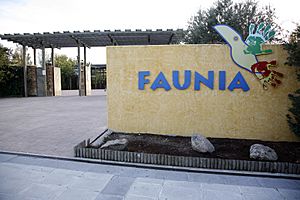Faunia facts for kids
 |
|
| Date opened | 10 July 2001 |
|---|---|
| Location | Madrid, Spain |
| Land area | 14 hectares (35 acres) |
| Coordinates | 40°23′31″N 3°36′45″W / 40.3919°N 3.6125°W |
| No. of animals | 4000 |
| No. of species | 500 |
| Memberships | EAZA, AIZA |
| Major exhibits | Sea lions, Exotic pets |
Faunia is an amazing place in Madrid, Spain, that is both a zoo and a botanical garden! It covers about 14 hectares (that's like 28 football fields!). Faunia is special because it's divided into different areas that look like real natural places. You can explore jungles, polar regions, and even an African forest, all in one spot.
This cool park first opened its doors on July 10, 2001. Back then, it was called Parque Biológico de Madrid. In 2002, its name changed to Faunia, which was created by a writer named Fernando Beltrán. A lot of people love visiting Faunia; in 2014, over 400,000 visitors came to see the animals and plants!
Amazing Animals at Faunia
Faunia is home to thousands of animals from all over the world. They have many different kinds of creatures, from tiny insects to large mammals. Let's explore some of the fascinating animals you can find there!
Creepy Crawlies: Invertebrates
Invertebrates are animals without a backbone. Faunia has some really interesting ones!
Spiders and Friends: Arachnids
- Mexican redknee tarantula (Brachypelma smithi)
- Red-legged tarantula (Nhandu carapoensis)
Bugs and Butterflies: Insects
- Giant stick insect (Eurycnema goliath)
- Atlas butterfly (Attacus atlas)
- Blue morpho butterfly (genus Morpho)
Underwater Wonders: Fish
Dive into the aquatic world at Faunia! You'll see many colorful and unique fish.
- Koi carp (Cyprinus carpio)
- Red lionfish (Pterois volitans)
- Arapaima (Arapaima gigas)
- Seahorses (genus Hippocampus)
- Red-bellied piranha (Pygocentrus nattereri)
- Blacktip reef shark (Carcharinus melanopterus)
- Regal tang (Paracanthurus hepatus)
Amphibians: Land and Water Dwellers
Amphibians can live both in water and on land. Faunia has a few cool ones!
Reptiles: Scaly Creatures
Reptiles are known for their scales and often live in warm places.
- Indian python (Python molurus)
- Spectacled caiman (Caiman crocodylus)
- Boa constrictor (Boa constrictor)
- Nile crocodile (Crocodylus niloticus)
- Komodo dragon (Varanus komodoensis)
Birds: Feathered Friends
Faunia has a wide variety of birds, from tiny songbirds to large water birds.
- American flamingo (Phoenicopterus ruber)
- Mute swan (Cygnus olor)
- Mandarin duck (Aix galericulata)
- Saker falcon (Falco cherrug)
- King penguin (Aptenodytes patagonicus)
- Humboldt penguin (Spheniscus humboldti)
- Toco toucan (Ramphastos toco)
- Scarlet macaw (Ara macao)
Mammals: Furry and Fun
Mammals are warm-blooded animals, and Faunia has many different kinds.
- Prairie dog (Cynomys ludovicianus)
- Guinea pig (Cavia porcellus)
- Harbor seal (Phoca vitulina)
- Indian flying fox (Pteropus giganteus)
- Linnaeus's two-toed sloth (Choloepus didactylus)
- Aardvark (Orycteropus afer)
- Ocelot (Leopardus pardalis)
- Ring-tailed lemur (Lemur catta)
- Golden lion tamarin (Leontopithecus rosalia)
- Naked mole-rat (Heterocephalus glaber)
Helping Animals: Conservation Programs
Faunia is not just a place to see animals; it also helps protect them! The park takes part in special programs called EEP (European Endangered Species Programmes) and ESB (European Studbooks). These programs are run by the European Association of Zoos and Aquaria (EAZA).
These programs help zoos work together to breed endangered animals. This helps make sure these amazing creatures don't disappear from our planet. In 2012, Faunia was involved in programs for 24 different species, and they even helped lead one for the white-headed marmoset!
See also
 In Spanish: Faunia para niños
In Spanish: Faunia para niños

